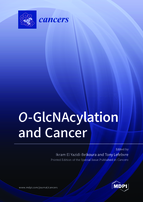O-GlcNAcylation and Cancer
A special issue of Cancers (ISSN 2072-6694). This special issue belongs to the section "Molecular Cancer Biology".
Deadline for manuscript submissions: closed (30 November 2021) | Viewed by 19221
Special Issue Editors
Interests: O-GlcNAcylation; cell signaling; nutrition; colorectal cancer; 5-Fluorouracil response
Special Issue Information
Dear Colleagues,
Cancer is one of the leading causes of morbidity and mortality worldwide, linked in part to deteriorating environmental conditions and unsafe lifestyles. Much progress has been made in recent decades in deciphering the etiology, origin, and causes of cancer, but much remains to be done to understand the molecular mechanisms underlying its initiation and progression. In recent years, O-GlcNAcylation has been found to be particularly disturbed in oncogenic processes, irrespective of the stage or molecular process considered. In particular, because of its strategic position as a metabolic hub, this post-translational modification could play a role of switch between nutritional disorders and cancer. This Special Issue is an opportunity to take stock of current knowledge on the subject and to project research into the near future, which should shed new light into our understanding of the impact of a shaken O-GlcNAcylation homeostasis, related or not with the nutritional and environmental aspects, on cancer and anticancer therapies.
Prof. Dr. Ikram El Yazidi-Belkoura
Prof. Dr. Tony Lefebvre
Guest Editors
Manuscript Submission Information
Manuscripts should be submitted online at www.mdpi.com by registering and logging in to this website. Once you are registered, click here to go to the submission form. Manuscripts can be submitted until the deadline. All submissions that pass pre-check are peer-reviewed. Accepted papers will be published continuously in the journal (as soon as accepted) and will be listed together on the special issue website. Research articles, review articles as well as short communications are invited. For planned papers, a title and short abstract (about 100 words) can be sent to the Editorial Office for announcement on this website.
Submitted manuscripts should not have been published previously, nor be under consideration for publication elsewhere (except conference proceedings papers). All manuscripts are thoroughly refereed through a single-blind peer-review process. A guide for authors and other relevant information for submission of manuscripts is available on the Instructions for Authors page. Cancers is an international peer-reviewed open access semimonthly journal published by MDPI.
Please visit the Instructions for Authors page before submitting a manuscript. The Article Processing Charge (APC) for publication in this open access journal is 2900 CHF (Swiss Francs). Submitted papers should be well formatted and use good English. Authors may use MDPI's English editing service prior to publication or during author revisions.
Keywords
- cancer
- O-GlcNAcylation
- molecular mechanism
- nutrition
- metabolism
- environment
- therapy







